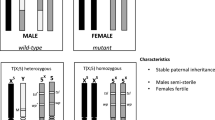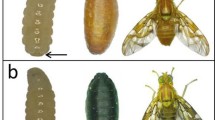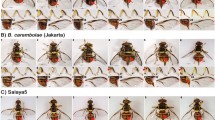Abstract
This report deals with the process of improving the stability of medfly, Ceratitis capitata, genetic sexing strains (GSS) based on the swmutation on chromosome 2. This gene affects the rate of development as well as the eye colour and iridescence. The improved sexing strains were produced by mapping swwith deletions and then inducing and screening for new translocations with breakpoints close to the marker. The stability was assessed in large populations over many generations. Twenty-two new Y-2 translocations were identified and polytene chromosome analysis was performed to locate breakpoints. The translocation strains were ranked according to the distance of their breakpoints from sw. The map position of swis region 20D on 2R. As data on the stability of the 22 strains accumulated, Cast191 was shown to be the most promising as no recombination between swand the male sex was found. After rearing the strain for 22 generations under semi-mass rearing conditions, with a population size of 15,000 adults and scoring 1000 flies per generation, only one such event was detected (estimated frequency = 3.1 × 10−6). Further tests are being carried out with this strain to assess its suitability as a genetic sexing strain for medfly Sterile insect technique (SIT).
Similar content being viewed by others
References
Bedo, D.G., 1986. Polytene and mitotic chromosome analysis in Ceratitis capitata(Diptera: Tephritidae). Can. J. Genet. Cytol. 28: 180–188.
Bedo, D.G., 1987. Polytene chromosome mapping in Ceratitis capitata(Diptera: Tephritidae). Genome 29: 598–611.
Busch-Petersen, E., 1989. Male recombination in a genetic sexing strain of Ceratitis capitata(Diptera: Tephritidae) and its effect on stability. Ann. Entomol. Soc. Am. 82: 778–784.
Busch-Petersen, E. &; A. Kafu, 1989. Stability of two mass-reared genetic sexing strains of Ceratitis capitata(Diptera: Tephritidae) based on pupal color dimorphisms. Environ. Entomol. 18: 315–322.
Busch-Petersen, E. &; D.I. Southern, 1987. Induced suppression of genetic recombination in females of the Mediterranean fruit fly, Ceratitis capitata(Wied.), by translocation heterozygosity. Genetica 72: 161–169.
Cladera, J.L., 1990. Recombinaciones excepcionales en el macho y supervivencia de cigotas aneuploides. PhD Thesis. University of Buenos Aires.
Cladera, J.L., 1995. Self-sexing strain of Ceratitis capitata(Diptera: Tephritidae) based on a gene that affects the rate of development. Ann. Entomol. Soc. Am. 88: 353–356.
Cladera, J.L., 1997. Genetic markers, translocations and sexing genes on chromosome 2 of Ceratitis capitata, pp. 75–83 in Evaluation of Genetically Altered Medflies for Use in Sterile Insect Technique Programmes, edited by Joint FAO/IAEA Division, Vienna, Austria.
Cladera, J.L. Mass rearing Cast-191. Quality control of males and females (in preparation).
Cladera, J.L. &; M.A. Delprat, 1995. Genetic and cytological mapping of a ‘Y-2’ translocation in the Mediterranean fruit fly Ceratitis capitata. Genome 38: 1091–1097.
Cladera, J.L., E. Lifschitz &; F. Manso, 1987. New evidence in the problem of recombination in Ceratitis capitatamales. A pupal marker and the effect of an altered Y-chromosome. Genet. Agric. 41: 57–70.
Cladera, J.L., M.T. Vera, G. Calcagno, J.C. Vilardi &; D.O. McInnis, 2002. Mating competitiveness of Cast-191, a promising genetic sexing strain of the Mediterranean fruit fly. Ann. Entomol. Soc. Am. 95: 133–138.
Franz, G., E. Gencheva &; Ph. Kerremans, 1994. Improved stability of genetic sex-separation strains for the Mediterranean fruit fly, Ceratitis capitata.Genome 37: 72–82.
Gourzi, P., D. Gubb, Y. Livadaras, C. Caceres, G. Franz, C. Savakis &; A. Zacharopoulou, 2000. The construction of the first balancer chromosome for the Medierannean fruit fly, Ceratitis capitata. Mol. Gen. Genet. 264: 127–136.
Lifschitz, E. &; J.L. Cladera, 1989. Cytogenesis and sex determination in Ceratitis capitataChapter 6.1.1, Vol. B, in Fruit Flies-Their Biology, Natural Enemies and Control, edited by A. Robinson &; Hopper. Elsevier, Amsterdam, The Netherlands.
Lifschitz, E., F. Manso, J.L. Cladera &; E.A. Favret, 1983. Genetic sex-sorting mechanisms for the Mediterranean fruit fly, pp. 21–25 in Research Co-ordination Meeting on the Development of Sexing Mechanisms in Fruit Flies through Manipulation of Radiation-induced Lethals and other Genetic Measures, edited by J.F.I. Division. IAEA, Vienna, Austria.
Manso, F.C. &; E. Lifschitz, 1992. Nueva metodología genética para el mejoramiento de la eficiencia de la técnica del macho estéril en el control de la mosca del Mediterráneo Ceratitis capitata. Ciencia e Investigación 44: 225–228.
Manso, F.C., J.L. Cladera &; E. Lifschitz, 1987. Screening for a female-limited temperature-sensitive lethal mutation induced on a Y-autosome translocated strain, in Ceratitis capitata, pp. 219–225 in Proceedings of the Second International Symposium on Fruit Flies, edited by A.P. Economopoulos. Elsevier, Amsterdam, The Netherlands.
McInnis, D.O., S. Tam, C. Grace &; D. Miyashita, 1994. Population suppression and sterility rates induced by variable sex-ratio, sterile-insect releases of Ceratitis capitatain Hawaii. Ann. Entomol. Soc. Am. 87: 231–240.
Pizarro, J.M., F.C. Manso &; J.L. Cladera, 1996. Sexado masivo usando el gen swen cepas de Ceratitis capitatacon fondo genético Mendoza. II Jornadas Argentino-Chilenas de Genética, Viña del Mar, Chile.
Pizarro, J.M., F.C. Manso &; J.L. Cladera, 1997. New allele at a locus affecting developmental time inMediterranean fruit fly and its potential use in genetic sexing at the egg stage. Ann. Entomol. Soc. Am. 90: 220–222.
Rendon, P., D.O. McInnis, D. Lance &; J. Stewart, 2000. Comparison of medfly male-only and bisexual releases in large scale field trials, pp. 517–525 in Area-wide Control of Fruit Flies and Other Insect Pests, edited by K.H. Tan. Penerbit Universiti Sains Malaysia Publisher, Pulau Pinang, Malaysia.
Robinson, A.S. &; M.E. Riva, 1984. A simple method for the isolation of allelic series using male-linked translocations. Theor. Appl. Genet. 67: 305–306.
Robinson, A.S. &; C. van Heemert, 1982. Ceratitis capitataa suitable case for genetic sexing. Genetica 58: 229–237.
Robinson, A.S., G. Franz &; K. Fisher, 1999. Genetic sexing strain in the medfly, Ceratitis capitata: development, mass rearing and field application. Trends Entomol. 2: 81–104.
Rössler, Y., 1979. Automated sexing of Ceratitis capitata(Diptera: Tephritidae): the development of strains with inherited sex-limited pupal color dimorphism. Entomophaga 24: 411–416.
Rössler, Y., 1982. Genetic recombination in males of the Mediterranean fruit fly, and its relation to automated sexing methods. Ann. Entomol. Soc. Am. 75: 28–31.
Rössler, Y., 1985. Effect of genetic recombination in males of the Mediterranean fruit fly (Diptera: Tephritidae) on the integrity of genetic sexing strains produced for sterile-insect releases. Ann. Entomol. Soc. Am. 78: 265–270.
Stolar, E., M.M. Viscarret &; J.L. Cladera, 2001. 4th Meeting of theWGFFWH, Mendoza 2001 Separation of Females and Males by Cooling of Larvae in a Genetic Sexing Strain of Ceratitis capitata(abstract).
Terán, H.R., 1977. Comportamiento alimentario y su correlación a la reproducción en hembras de Ceratitis capitata(Wied.) (Diptera: Trypetidae). Revista de Agronomía del Nor-Oeste Argentino 14: 17–34.
Author information
Authors and Affiliations
Rights and permissions
About this article
Cite this article
Delprat, M., Stolar, C., Manso, F. et al. Genetic Stability of Sexing Strains Based on the Locus swof Ceratitis Capitata . Genetica 116, 85–95 (2002). https://doi.org/10.1023/A:1020963709795
Issue Date:
DOI: https://doi.org/10.1023/A:1020963709795




